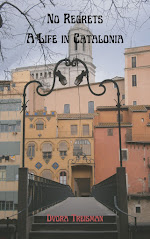A 19th century iron and glass modernista structure, the Boqueria is located on La Rambla in the heart of the city. In its early days, it was an open market outside the city walls (which ended at what is now La Rambla ), making it easier for the farmers to bring their goods and not have to encounter officials at the city gates nor pay the taxes required to enter the city with their goods. When the city expanded, the market remained where it was, eventually becoming a central location. It was porticoed in 1840 and covered in 1865. It now has 300 stalls and is the biggest mercat in Spain
The food on display throughout the market is laid out beautifully. When you walk up and down the aisles, the stacks of fruit and vegetables become colorful geometrical abstractions -- patches of pink, yellow, brown, or green. Bring them into focus and they're pomegranates, lemons, kiwis, and artichokes.
The tremendous variety of food includes all the summer fruits and vegetables that we're used to in California
To be honest, some of the displays of meat -- particularly those of hanging dead rabbits or little skinned dead piglets with their heads still on -- are far less appealing than the peaches, oranges, and green beans. Meat is simply more appetizing when it doesn't look like what it really is.
For the six months each year when Ferran Adria (one of the world’s greatest chefs, who of course buys only the best ingredients) was not making culinary magic at El Bulli on the Costa Brava, he was shopping every morning at the Boqueria to conjure up culinary alchemy at his nearby laboratory on Carrer Portaferrissa in the Barri Gotic. Shopping every morning is typical here.
Every mercat has one or more bars that serve food and drink. They tend to buy their supplies fresh from their neighbors who then come to eat what they’ve cooked. The food is always very fresh and often wonderfully good.
Pinotxo (Pinocchio), a tiny bar just to the right of the main entrance, is one of several bars where you can eat in the Boqueria. It is owned and run by Joan, a middle-aged man who wears a crisply ironed shirt, a bow tie, and a smile no matter how oppressive the summer heat and humidity. Joan works with two nephews and two other helpers. There are five of them working behind the twelve-foot counter with stools for ten in front. The food is fresh, homemade, and delicious. If you want to know what they have today, you ask, there being no carte (menu).
When I lived in Barcelona












No comments:
Post a Comment